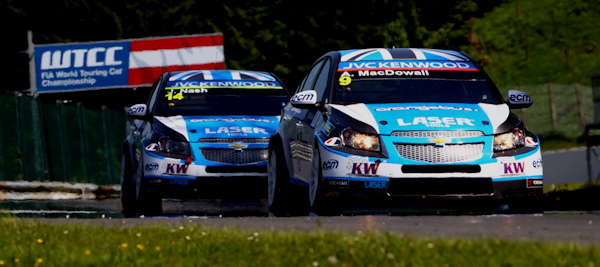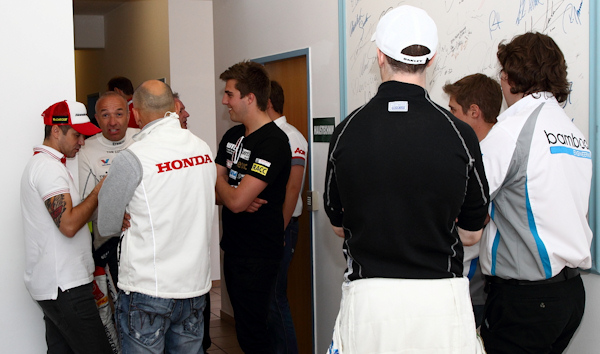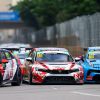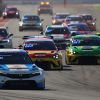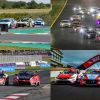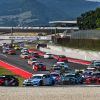When qualifying was turned upside down
On Saturday we saw one of the most surreal qualifying sessions in motorsport at the fifth round of this year’s FIA World Touring Car Championship, and then it was followed up with an equally bizarre handing down of penalties which effectively put ten of the Championship’s front-runners at the back of the pack.
Why did it happen? Essentially it’s all about the slipstream effect, very common in NASCAR for example on Superspeedway races, not so common in motorsports where there’s a lot of aerodynamic work able to be done to the cars to minimise it; and WTCC’s Super 2000 cars with their very standard road car-based shapes can give off quite a slipstream at the right kind of circuit.
Getting a good slipstream has been the story of qualifying in four of this year’s races already at Monza, Marrakech, the Slovakiaring and now the Salzburgring.
At Salzburg a good slipstream was reportedly worth over half a second, and as Tom Chilton headed out on his final run in qualifying, nine of the other drivers shot out of the pits behind him like they were chasing the lure in a Greyhound race.
Chilton was quick enough through the first sector of the track and then suddenly slowed to a crawl up the back straight, saying afterwards he was discussing with his team whether he would be able to hold everyone up and not cross the line before chequered flag fell, realising that all that was at risk was his own grid position.
If another driver had passed him, then qualifying would have been all go, but every driver had realised that if they went, then their lap time wouldn’t have improved because they wouldn’t have had the benefit of the slipstream, and yet any or all of those behind them could and would then out-qualify them.
We know that on our own we couldn’t improve the time we could have done, so you either need somebody to pull you or you’re just not going to improve, so I was hoping somebody would go for it and then when I realised that it was going to be really tight I wondered if I should go, but I was 99% certain than (if I set a lap) on my own I wouldn’t improve, and if I did go everyone would follow me and they would improve. It might have looked a bit stupid from the outside, but in these kind of cars the tow is important and it was all strategy.
Honda driver Tiago Monteiro after qualifying
Tom Coronel had not yet set a time at all, and with top ten being vital to make sure of a good starting position in the second race where the top ten are reversed, the Dutchman needed to get a move on, but likewise wanted to make sure he was in the tow of someone else, and so he still held back. This saw him effectively block the only driver in the who never slowed down on his out-lap at all, the bamboo-engineering Chevrolet of James Nash.
Coronel eventually bolted, but unfortunately it was too late and he still hit the chequered flag (though his team didn’t tell him, which saw him push too hard and go off the circuit into the tyre barriers on what should have been his in-lap). The session finished without anyone able to set a final run in qualifying, and the grid effectively set by everyone’s first lap time, with Yvan Muller on pole position ahead of Tom Chilton.
The slipstream is very important, but it’s better to have no slipstream than no lap time
Yvan Muller
The feeling afterwards was one of total bemusement at the circuit. The top drivers in qualifying didn’t understand why no one decided to go, but behind the dominant pair of Chevrolets, with third place to tenth covered by just four-tenths of a second and with a slipstream worth anything from half a second to seven or eight-tenths, everyone came to the collective conclusion that it was better not to try and set a lap at all and take the position they already had.
For about two hours that seemed to be it, we’d seen one of the strangest qualifying sessions in this history, and perhaps in any motorsport, but we had a pretty ordinary grid with points leader and three-time champion Yvan Muller on pole ahead of his RML team-mate.
Rob Huff was happy with his third place, given that this circuit did not favour the SEAT at all, Alex MacDowall had the Yokohama Drivers’ Trophy class pole position with fourth, the two works Hondas were in the middle of the top ten for both races and set for a strong points race, and Norbert Michelisz in the independently run Zengõ Motorsport Honda would line-up behind James Nash for the reversed grid race, with Nash and Nika Racing’s Michel Nykjaer the only two drivers not to get involved with all the “going slow” situation in Q2.
Then, 14 drivers were called to the stewards. This was 11 of the top 12 that were in the second part of qualifying and three drivers from the first part of qualifying, where some similar backing off was also at play, though certainly not to the same extent.
The drivers were questioned by the three stewards, with no experienced driver advisor present this weekend as per the last three meetings, explaining that they had let the fans and the sport down with the show that had just been put on.
As the stewards deliberated, the question was what possible outcome would there be? Would they all get a warning, or probably a fine (there are always fines), 1,000 EUR each perhaps? Maybe they’ll give Chilton a grid penalty, as he was the one at the front, as they can’t punish them all surely? Maybe they’ll use Q1 times instead, but that’s not exactly fair as no one’s really pushing for P1 in Q1, just the top 12…and also that would just give Chilton pole?
The drivers were called in one by one, Tom Chilton first who emerged and told the rest he had a 12 place penalty and a 3,000 EUR fine. When Yvan Muller got the same penalty and then both of the two Honda drivers, it was clear this was being treated very seriously by the stewards.
The reasoning behind each penalty and the differences reportedly were related to the speed of the drivers on their out lap and as to how much they blocked other drivers in qualifying, both in Q1 and Q2, which if a driver offended twice (as did Gabriele Tarquini, Tom Coronel and Pepe Oriola), their penalties were added together, which saw Tarquini accumulate an ‘impressive’ 24 position grid drop.
The drivers were certainly upset over the whole affair, but generally considered on race day. The general feeling amongst all the drivers was that it probably did look quite strange for the fans and that something should be done to ensure it doesn’t happen again, but then again that perhaps to punish everyone so severely the first time something like this has happened was perhaps a little over the top.
“Our speed was quite low for sure, but not much lower than a rolling start, that is 70km/h and here we were between 50km/h and 60km/h and it was nothing dangerous,” said Yvan Muller to AUTOSPORT.
“The most important thing, and the clever thing, is not to penalise the people but is to find a way it will not happen again. I think that is most important. I think that will be more clever, to find a way to resolve the problem.”
As the penalties were rolled out through the evening, it was certainly worth considering whether the stewards were in fact adding to the confusion of the casual fan. Anyone in attendance on Saturday would have gone home thinking the two RML drivers were on the front row. They would have come back on Sunday to find Michel Nykjaer’s black and white Chevrolet on pole and the driver who qualified tenth now starting in second position, with all the fast drivers at the back of the grid.
There was also all the more potential for chaos on race day. The grid for the first race was perhaps even more randomised than the second race which actually featured the reverse grid, with some drivers very out of place compared to their usual qualifying performances so far this year.
Thankfully nothing too dramatic happened during the race and Nykjaer had a good fight up front with James Nash whilst it was also great to watch the Chevrolets of Yvan Muller and Alex MacDowall charge their way up through the field, whilst arguably if the race has been run with the original grid, Muller could well have sailed off into the distance considering the pace he had shown throughout practice and in qualifying.
The buzz around qualifying perhaps overshadowed race day a little as well. Though we saw two high standard races as usual from the WTCC, the day’s preceding story perhaps got in the way more than it should have.
Preventing this from happening again is key, and it was clear the stewards have decided to make that abundantly clear, though whilst perhaps setting a rather dangerous precedent in establishing that “driving too slowly” could get you a pretty extreme grid drop and a hefty fine. Don’t forget, this wasn’t blocking, any driver was more than welcome to pass, in fact that was the whole point. A slow out-lap is now in theory worthy of a penalty – hey, maybe even a slow in-lap, the regulation just says you shouldn’t drive slowly or erratically in any session, doesn’t matter if it’s a flying lap or not.
It’s worth noting that anything like this didn’t happen last year, and that’s perhaps because there was a little more coordination, particularly at Chevrolet, who had an inter-team arrangement between their drivers to tow each other in turn and maximise qualifying for all three cars, whilst this year that dynamic doesn’t exist. This kind of thing could easily have happened at Monza as well, the catalyst was Tom Chilton and RML’s decision to not even try to do a lap. It wasn’t a severe crime, it was just a severe outcome.
Already the talk of how to fix this was floating around the paddock, but with no real sense of urgency. This could quite possibly have never happened again even with no action taking place, but now with the fines and penalties, enough has already perhaps been done to discourage the drivers from ever doing it again, though what could possibly have happened if we replayed Salzburg’s Q2 again right now instead is that no driver would have gone out again.
There are no more tracks where a slipstream is that important this season, and by next season it could well be the case the field are running new cars with a very different aero package which may make the slipstream a lot less important.
In summary, we saw something very odd happen in qualifying on Saturday. Why it happened makes perfect sense. Should it have happened? Certainly not.
We also saw a very strong reaction from the stewards, who opted to be the voice of the extremely disgruntled and punish all of the drivers and make an example of them, instead of perhaps the other viable option of working with them to ensure it doesn’t happen again in a more collective manner.
Thankfully, as the weekend panned out, it probably hasn’t had too much of an effect on the championship, with Muller still scoring the most as he was set to before qualifying changed and considering Honda’s separate penalty for a non-conforming rear wing.
There’s been a little bit of publicity and awe about the WTCC as a result of the weekend, though unfortunately all the talk is of qualifying and not about the racing, though the fear of there being any actual ‘damage’ to the Championship is overstated.
This was just one of those events where a set of strange circumstances collide together to create a very memorable moment in motorsport history. In the end, the ‘bad’ events always stick in people’s minds, Formula 1 USA 2005, WTCC Pau 2009, DTM Barcelona 2007 – they’re all remembered for the wrong reasons, but it’s an overreaction to say that there is any damage to the sport because of it, just as long as it doesn’t become the norm.

